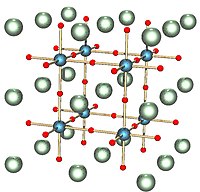
Photo from wikipedia
Abstract Nickel is often applied in heterogeneous catalysis for its high catalytic activity towards a large variety of reactions at affordable price. Nickel reduction from perovskite-type mixed oxides is increasingly… Click to show full abstract
Abstract Nickel is often applied in heterogeneous catalysis for its high catalytic activity towards a large variety of reactions at affordable price. Nickel reduction from perovskite-type mixed oxides is increasingly exploited to generate active and stable Ni catalysts. To investigate implications of the host perovskite structure on Ni reducibility, Ni was incorporated on the B-site of three perovskite-type mixed metal oxides of different lattice symmetries (LaFeO3 – orthorhombic, LaCoO3 – rhombohedral and La0.3Sr0.55TiO3 – cubic). Structural parameters of the phase pure undoped and Ni-doped perovskites were determined using synchrotron X-ray diffraction (XRD) and Ni K-edge X-ray absorption spectroscopy (XAS). Rietveld refinement and extended X-ray absorption fine structure (EXAFS) data fitting were used to verify that at this substitution level Ni enters the B-site and adopts its coordination environment. Expansion of the unit cell was found in LaCoO3 and La0.3Sr0.55TiO3, whereas contraction was observed in the case of LaFeO3. X-ray absorption spectra showed that Ni-containing unit cells exhibit the same symmetry as the host perovskite-type mixed oxides. The mean oxidation state of Ni was found to be equal in all three cases irrespective of the host lattice (+2.5). Lattice symmetry had significant effect on lowering the Ni reduction temperature determined by hydrogen temperature programmed reduction and a correlation between reduction temperature and crystal tolerance factor was found.
Journal Title: Acta Materialia
Year Published: 2019
Link to full text (if available)
Share on Social Media: Sign Up to like & get
recommendations!